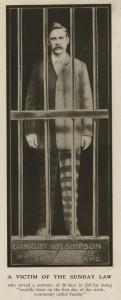How much do you know about your ancestors? What do you know about the lives they lived? Were any of them Seventh-day Adventists (SDA)? If you are interested in genealogy and have Adventist connections, you will find the Center for Adventist Research (CAR) to be a great resource. Many of the benefits CAR offers are freely accessible online at http://www.centerforadventistresearch.org.
 The SDA Obituary Index is an invaluable tool for locating obituaries that were printed in SDA periodicals. You are able to search for these records by keyword, name, date, or periodical title. Let’s say I decide to search by name for my great-grandfather’s first wife. I enter “Hopkins, Violet” in the search bar and click the search button. From the results I learn that there is an obituary that appears in the Advent Review and Sabbath Herald, March 29, 1923. Though this information appears as a link it will not take me to the obituary if I were to click on it. At this point, it is necessary to go to another website to actually find the obituary. So, I open a new window and go to https://www.adventistarchives.org. Once I am on this site I use the reference I found in the SDA Obituary Index to search the “Online Archives” for the periodical that contains the obituary I want to find.
The SDA Obituary Index is an invaluable tool for locating obituaries that were printed in SDA periodicals. You are able to search for these records by keyword, name, date, or periodical title. Let’s say I decide to search by name for my great-grandfather’s first wife. I enter “Hopkins, Violet” in the search bar and click the search button. From the results I learn that there is an obituary that appears in the Advent Review and Sabbath Herald, March 29, 1923. Though this information appears as a link it will not take me to the obituary if I were to click on it. At this point, it is necessary to go to another website to actually find the obituary. So, I open a new window and go to https://www.adventistarchives.org. Once I am on this site I use the reference I found in the SDA Obituary Index to search the “Online Archives” for the periodical that contains the obituary I want to find.
The Adventist Archives website, which is managed by the General Conference Office of Archives, Statistics, and Research, is also a great tool for genealogical research. You can use it to search for the names of your ancestors, or even places they lived. I was doing some searching on August 14, 2013, and discovered an article about one of my great-great-grandmas. To my surprise the article mentioned that she became an Adventist in 1896. This meant that Emily Alice Roberts was the first Seventh-day Adventist in my family, making me a fifth-generation Adventist. Before this time my family had assumed that my great-grandparents were the first to accept the Adventist faith. There may also be some interesting things about your ancestors that are waiting to be discovered as well!

Another valuable tool on CAR’s website is the SDA Periodical Index. The searching capabilities for this feature are similar to the Obituary Index. In May 2013 I used the Periodical Index to find articles written by my grandpa, Marvin Gunter. My search yielded 12 hits, which I was able to find on the Adventist Archives website just like I had done for the obituaries. My mother and I really enjoyed going through these articles and reading about my grandpa’s involvement in various projects and ministries.
One other beneficial feature available on CAR’s website is the photographs. The methods for searching the photos are completely different from the obituary and periodical indexes. There is a search box in the upper right-hand corner of the window. If you search for a word in this box it will search multiple fields for key words. You can be more specific, however, by using “quotation marks.” When searching, it is also important to keep in mind that names are usually given “last name first, first name, middle name last” (to quote from the classic Andy Griffith film, No Time for Sergeants). In other words, when I searched for a picture of my wife’s grandpa, I typed “Gane, Erwin R” in the search box. Once my search popped up, I saw a picture of Grandpa Gane when he was president of his graduating class at the Seventh-day Adventist Theological Seminary in the 1960s. After this, I clicked on the link to download the “Full Resolution Image” so I could have a nice copy.
About 170 years have passed in the Adventist movement and many people have ancestors who were part of this history. Therefore, CAR is not only for theologians and historians, but also for all that like to learn more of their family’s history. Stories abound in the Seventh-day Adventist Church, stories of which your ancestors were a part. Are you ready to make new discoveries and put these stories back together? If so, your quest begins at http://www.centerforadventistresearch.org.
“Every man is a quotation from all his ancestors”
–Ralph Waldo Emerson
Kevin Burton, Staff Assistant / Shops for Adventist history on ebay in his spare time.











